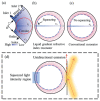Recent Development of Tunable Optical Devices Based on Liquid
- PMID: 36432123
- PMCID: PMC9694320
- DOI: 10.3390/molecules27228025
Recent Development of Tunable Optical Devices Based on Liquid
Abstract
Liquid opens up a new stage of device tunability and gradually replaced solid-state devices and mechanical tuning. It optimizes the control method and improves the dynamic range of many optical devices, exhibiting several attractive features, such as rapid prototyping, miniaturization, easy integration and low power consumption. The advantage makes optical devices widely used in imaging, optical control, telecommunications, autopilot and lab-on-a-chip. Here, we review the tunable liquid devices, including isotropic liquid and anisotropic liquid crystal devices. Due to the unique characteristics of the two types of liquids, the tuning principles and tuning methods are distinguished and demonstrated in detail firstly and then some recent progress in this field, covering the adaptive lens, beam controller, beam filter, bending waveguide, iris, resonator and display devices. Finally, the limitations and future perspectives of the current liquid devices are discussed.
Keywords: adaptive liquid lens; beam steering; design; liquid; liquid crystal; optical device; optical filter; tunable.
Conflict of interest statement
The authors declare no conflicts of interest.
Figures



































Similar articles
-
Optofluidic-tunable color filters and spectroscopy based on liquid-crystal microflows.Lab Chip. 2013 Jul 21;13(14):2721-6. doi: 10.1039/c3lc50501d. Lab Chip. 2013. PMID: 23752198
-
A large bistable negative lens by integrating a polarization switch with a passively anisotropic focusing element.Opt Express. 2014 Jun 2;22(11):13138-45. doi: 10.1364/OE.22.013138. Opt Express. 2014. PMID: 24921509
-
Three-stage Fabry-Perot liquid crystal tunable filter with extended spectral range.Opt Express. 2011 Jan 31;19(3):2158-64. doi: 10.1364/OE.19.002158. Opt Express. 2011. PMID: 21369033
-
Electrically Tunable Lenses for Imaging and Light Manipulation.Micromachines (Basel). 2023 Jan 26;14(2):319. doi: 10.3390/mi14020319. Micromachines (Basel). 2023. PMID: 36838021 Free PMC article. Review.
-
Liquid Crystal Devices for Beam Steering Applications.Micromachines (Basel). 2021 Feb 28;12(3):247. doi: 10.3390/mi12030247. Micromachines (Basel). 2021. PMID: 33671001 Free PMC article. Review.
Cited by
-
Enhanced Infrared Shielding Function in ATO-Doped Polymer-Dispersed Liquid Crystal Films.Molecules. 2025 Apr 11;30(8):1730. doi: 10.3390/molecules30081730. Molecules. 2025. PMID: 40333711 Free PMC article.
-
Emerging Trends in Thermo-Optic and Electro-Optic Materials for Tunable Photonic Devices.Materials (Basel). 2025 Jun 13;18(12):2782. doi: 10.3390/ma18122782. Materials (Basel). 2025. PMID: 40572914 Free PMC article. Review.
-
A Stable PDLC Film with High Ageing Resistance from an Optimized System Containing Rigid Monomer.Molecules. 2023 Feb 16;28(4):1887. doi: 10.3390/molecules28041887. Molecules. 2023. PMID: 36838878 Free PMC article.
-
Full Spectrum Electrochromic WO3 Mechanism and Optical Modulation via Ex Situ Spectroscopic Ellipsometry: Effect of Li+ Surface Permeation.Micromachines (Basel). 2024 Dec 5;15(12):1473. doi: 10.3390/mi15121473. Micromachines (Basel). 2024. PMID: 39770226 Free PMC article.
References
-
- Xu S., Ren H., Wu S.-T. Dielectrophoretically Tunable Optofluidic Devices. J. Phys. D Appl. Phys. 2013;46:483001. doi: 10.1088/0022-3727/46/48/483001. - DOI
Publication types
MeSH terms
Grants and funding
LinkOut - more resources
Full Text Sources
Miscellaneous

